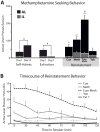A rodent "self-report" measure of methamphetamine craving? Rat ultrasonic vocalizations during methamphetamine self-administration, extinction, and reinstatement
- PMID: 22940018
- PMCID: PMC3482304
- DOI: 10.1016/j.bbr.2012.08.023
A rodent "self-report" measure of methamphetamine craving? Rat ultrasonic vocalizations during methamphetamine self-administration, extinction, and reinstatement
Abstract
Rats emit ultrasonic vocalizations (USVs) in a variety of contexts, and it is increasingly clear that USVs reflect more complex information than mere positive and negative affect states. We sought to examine USVs in a common model of addiction and relapse, the self-administration/reinstatement paradigm, in order to gain insight into subjective states experienced by rats during various types of methamphetamine seeking. We measured three subtypes of "50kHz" USVs [flats, trills, and non-trill frequency modulated (FM) USVs], as well as long and short duration "22kHz" USVs, during self-administration and extinction training, and during reinstatement elicited by cues, a methamphetamine prime, cues+prime, or the pharmacological stressor yohimbine. During self-administration and extinction, rats emitted many flats and FMs, (and short duration "22kHz" USVs on day 1 of self-administration), but few trills. In contrast, methamphetamine priming injections potently enhanced FMs and trills, and trill production was correlated with the degree of methamphetamine+cue-elicited reinstatement. Cues alone yielded increases only in flat USVs during reinstatement, though a subset of rats displaying strong cue-induced reinstatement also emitted long duration, aversion-related "22kHz" USVs. Although yohimbine administration caused reinstatement, it did not induce "22kHz" USVs in methamphetamine-experienced or methamphetamine-naïve rats (unlike footshock stress, which did induce long duration "22kHz" USVs). These findings demonstrate heterogeneity of rat USVs emitted during different types of methamphetamine seeking, and highlight their potential usefulness for gaining insight into the subjective states of rats in rodent models of drug addiction and relapse.
Copyright © 2012 Elsevier B.V. All rights reserved.
Figures





Similar articles
-
Incubation of extinction responding and cue-induced reinstatement, but not context- or drug priming-induced reinstatement, after withdrawal from methamphetamine.Addict Biol. 2017 Jul;22(4):977-990. doi: 10.1111/adb.12386. Epub 2016 Mar 14. Addict Biol. 2017. PMID: 26989042 Free PMC article.
-
Extended methamphetamine self-administration enhances reinstatement of drug seeking and impairs novel object recognition in rats.Psychopharmacology (Berl). 2008 Sep;199(4):615-24. doi: 10.1007/s00213-008-1187-7. Epub 2008 May 21. Psychopharmacology (Berl). 2008. PMID: 18493748 Free PMC article.
-
Effect of yohimbine on reinstatement of operant responding in rats is dependent on cue contingency but not food reward history.Addict Biol. 2015 Jul;20(4):690-700. doi: 10.1111/adb.12164. Epub 2014 Jul 27. Addict Biol. 2015. PMID: 25065697 Free PMC article.
-
Rat Ultrasonic Vocalizations and Behavioral Neuropharmacology: From the Screening of Drugs to the Study of Disease.Curr Neuropharmacol. 2015;13(2):164-79. doi: 10.2174/1570159x13999150318113800. Curr Neuropharmacol. 2015. PMID: 26411760 Free PMC article. Review.
-
The reinstatement model of drug relapse: recent neurobiological findings, emerging research topics, and translational research.Psychopharmacology (Berl). 2013 Oct;229(3):453-76. doi: 10.1007/s00213-013-3120-y. Epub 2013 May 18. Psychopharmacology (Berl). 2013. PMID: 23685858 Free PMC article. Review.
Cited by
-
Reinstatement of Pavlovian responses to alcohol cues by stress.Psychopharmacology (Berl). 2023 Mar;240(3):531-545. doi: 10.1007/s00213-022-06255-w. Epub 2022 Oct 13. Psychopharmacology (Berl). 2023. PMID: 36227353 Free PMC article.
-
Ultrasonic vocalizations: evidence for an affective opponent process during cocaine self-administration.Psychopharmacology (Berl). 2014 Mar;231(5):909-18. doi: 10.1007/s00213-013-3309-0. Epub 2013 Nov 7. Psychopharmacology (Berl). 2014. PMID: 24197178 Free PMC article.
-
Ventral Pallidum GABA Neurons Mediate Motivation Underlying Risky Choice.J Neurosci. 2021 May 19;41(20):4500-4513. doi: 10.1523/JNEUROSCI.2039-20.2021. Epub 2021 Apr 9. J Neurosci. 2021. PMID: 33837052 Free PMC article.
-
Comparing rewarding and reinforcing properties between 'bath salt' 3,4-methylenedioxypyrovalerone (MDPV) and cocaine using ultrasonic vocalizations in rats.Addict Biol. 2018 Jan;23(1):102-110. doi: 10.1111/adb.12479. Epub 2016 Dec 1. Addict Biol. 2018. PMID: 27910188 Free PMC article.
-
Trace Amine-Associated Receptor 1 Regulation of Methamphetamine Intake and Related Traits.Neuropsychopharmacology. 2015 Aug;40(9):2175-84. doi: 10.1038/npp.2015.61. Epub 2015 Mar 5. Neuropsychopharmacology. 2015. PMID: 25740289 Free PMC article.
References
-
- Childress AR, Hole AV, Ehrman RN, Robbins SJ, McLellan AT, O’Brien CP. Cue reactivity and cue reactivity interventions in drug dependence. NIDA research monograph. 1993;137:73–95. - PubMed
-
- Sinha R, Catapano D, O’Malley S. Stress-induced craving and stress response in cocaine dependent individuals. Psychopharmacology. 1999;142:343–51. - PubMed
-
- Jaffe JH, Cascella NG, Kumor KM, Sherer MA. Cocaine-induced cocaine craving. Psychopharmacology. 1989;97:59–64. - PubMed
-
- de Wit H, Stewart J. Reinstatement of cocaine-reinforced responding in the rat. Psychopharmacology. 1981;75:134–43. - PubMed
-
- Kalivas PW, McFarland K. Brain circuitry and the reinstatement of cocaine-seeking behavior. Psychopharmacology. 2003;168:44–56. - PubMed
Publication types
MeSH terms
Substances
Grants and funding
LinkOut - more resources
Full Text Sources
Other Literature Sources
Medical
Miscellaneous

